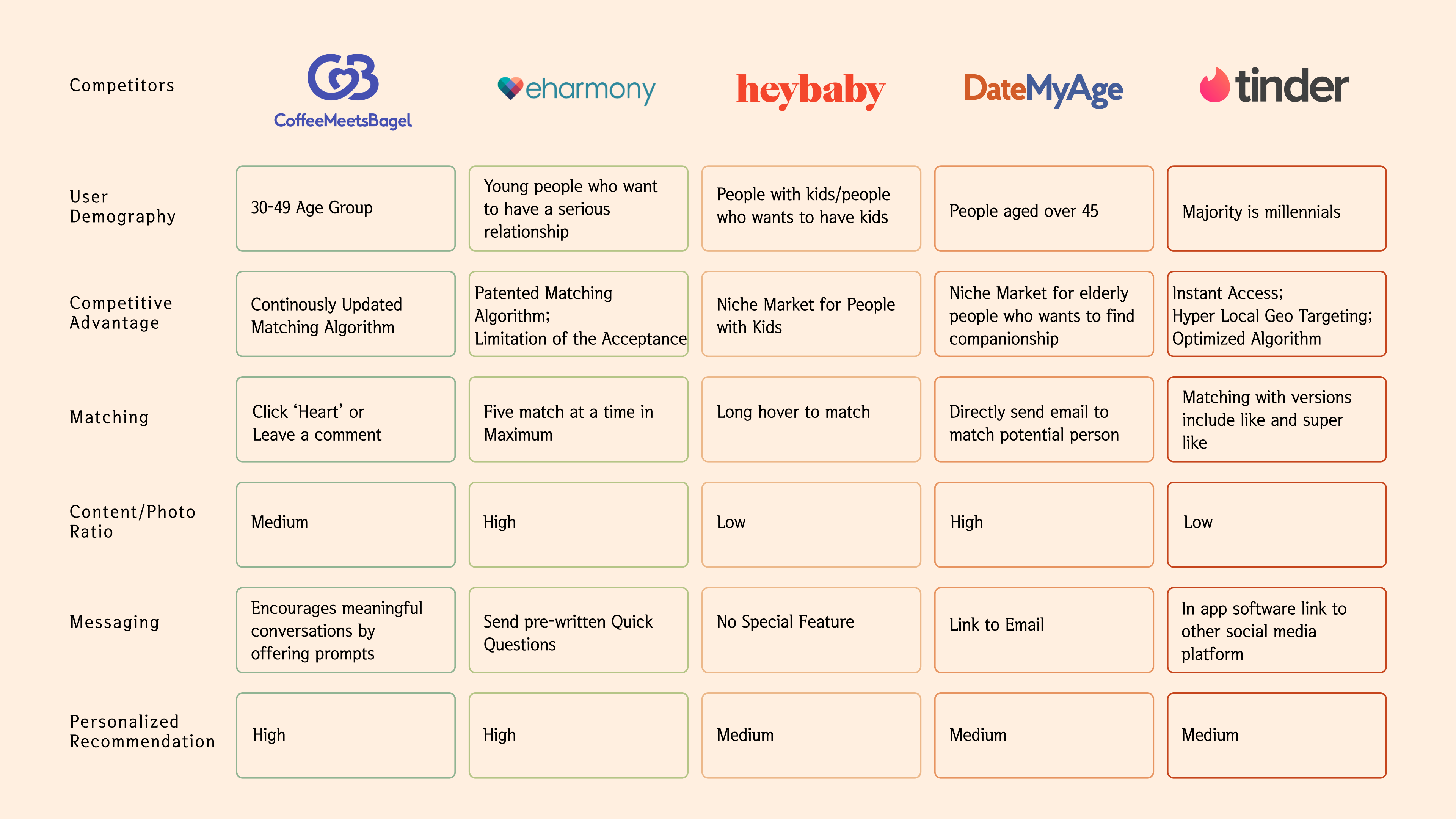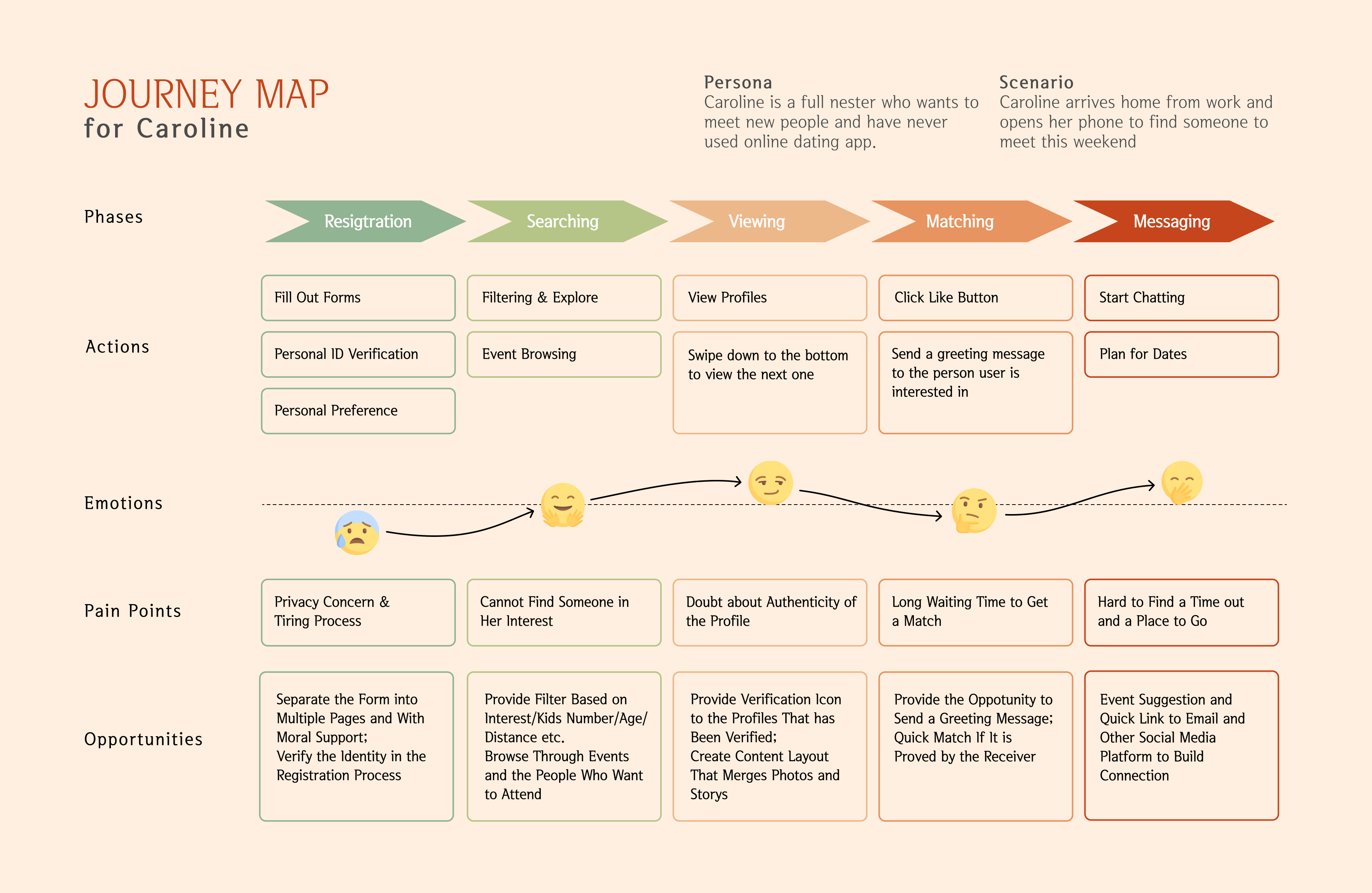
REUNION
Using quantitative and qualitative methods, our team took a human-centered approach to create single parents dating experiences with trust and responsibility.
For single parents who are looking to date in NYC or other cities, Reunion is a dating app that helps single parents find the time to meet available and interesting people. Unlike depthless apps such as Tinder or Hinge, Reunion takes into account the tight schedules and priorities that come with being a single parent.
Duration
Sep. 2021 – Oct. 2021
8 weeks
Tools
Role
Competitive Analysis
User Research
Visualization
Team
Sophia
Hilda
Problem Space
A lot of dating apps have emerged in recent years in our fast-paced life. However, a large portion of these apps are targeted towards the young-age groups that are more familiar with digital devices and also generally more active in meeting and dating strangers. However, they do not work out pretty well for more mature adults, and to further narrow it down, single parents, who have less time to meet different strangers from all different backgrounds but are more prone to use their treasured time to get to know about people that match them. Moreover, single parents come to the app with their children as part of their life.
An app should be developed that can better fit their specific situations so that they can have a truly comfortable and pleasant dating experience.
01
Strategy Document
Our team starts the research by writing out a strategy document for single parents dating app. In the document, we identified our target user demographic, analyzed our product objectives, and set success metrics for our app. We also made a competitive analysis about the current dating apps in the market to identify the blank space for single parents.
Users demographics
Single parents
Singles looking to date single parents
Mid-aged Full/empty nester
Used to/not familiar with online dating
Product Objectives
Increase efficiency and accessibility of older adults using apps to date
Enhance the seriousness and reliability of online dating for people who have family
Secure the personal information for people on the platform
Success Metrics
The number & penetration of older adults using our app to date
The success rate for matching
Competitive Analysis
This table compiles some of the more popular dating apps on the market, some of which focus more on in-depth communication, and some of which lean more towards speed dating. The apps that favor deeper communication have some special features to increase people’s understanding of each other.

02
Research
Then we started to roll out the plan for primary research for our target users. Based on the secondary research (competitive analysis, blog posts, podcasts & literature reviews), we listed some key concerns related to our app. Then we set a research objective and filled in the questions for the interview and survey.
Key Concerns
Targeting older demographic
Phone-use activity
Busy/tight schedule
Children come as package with single parents
Safety
Value: care, trust, responsibility, etc
Expanding family
Research Goals
Better understand the concerns of single parents when they date.
Find out what differs the single parents’ group from other groups of people that use dating apps
Understand their standards for creating a new family and dating others
Understand their expectations for a dating app.
Understand how they manage their dating life along with their daily routines (work, kids, family stuff)
Research Methods
Survey: 35 single parents aged between 30-50
– Quantitative questions
– Qualitative questions
Interview: 5 single parents aged between 30-50
03
Research Findings
After doing the survey and interview, we analyzed results from our participants and compared with our secondary research in order to map out the jobs-to-be-done for our app.
Demographics
Kids
21% Empty Nester whose kids have gone to
79% Full Nesters who have a baby around 3 and need good care
Status
90% Divorced
5% Separated
5% Widowed
Dating Experience
53% Newly dating
32% Experienced Dater
15% Did/did not use dating apps before
Ideal Partner
90% Honesty/Responsibility
88% Their attitudes towards kids
64% Hobbies
32% Occupations
Emotions
Nervous to start dating again
Have no idea how dating app would work and whether it is safe to use them
Feel awkward and uncomfortable in some dating situations
It is hard to find one that would be suitable for a deeper relationship after dating
Concerns
Data Authenticity
No prior app experiences
Nervousness of starting date again
Fear of meeting someone who is not serious toward relationship
Jobs-to-be-done
Provide a Relaxing Matching/Dating Experience
Build trust in the relationship
Help user get used to online dating environment
Reduce the concern about personal security
Release their stress of having the identity as a single parent
04
User Case
Since the majority of our target users are either empty nesters or full nesters, we create two personas for the certain demographic. Then we analyzed the user journey for the users and drew out the ideal user flow for them to have the best dating experience.
Persona
Catherine and Caroline are two very distinct types of mother/dater. One has a focus on dating and is very experienced while the other has a focus on kids and very little experience in online dating.

Journey Map
The user journeys for the two types of people are quite similar in our app. We worked on each of the dating steps to provide a fluent and pleasing experience for both first-time daters and those experienced ones.

User Flow
As for the app’s functionality, we created three different routes for users to find their best partner to date.

05
Visualization
Wireframing
Our team then made the wireframes for both the onboarding process and the search-for-date process. As we kept in mind the main concerns for our personas, we designed the onboarding process with identity verification and detailed questions. Shown in the user flow, we created three routes for people to meet others – explore, events, and profile page.
To make matching easier, we created a message button for people to send out hello messages to their preferred ones. It would directly show on the other’s chat page with an option to accept or decline. We also created the group dating experience in the event section for those who would like to have a more relaxing environment. In the chat pages, we made it easy for first-time online daters to directly telephone or schedule a date with their potential partner.
Visualization
One of the main issues when we were doing the user testing with the wireframes was the onboarding process – people could easily lose patience when filling out the long forms and providing a ID verification may make some people feel that their privacy is being invaded. So when I drew the visualization, I redesigned the onboarding experience with gamified elements and positive guiding words.
Another important issue I was focusing on was the readability of our app. Since our target demographic are middle-aged people, larger fonts and clearer information layout is needed to may their experience more joyful.
The Onboarding Flow
The redesigned onboarding experience is separated into a personal information section and a personal preference section with a signature section at the very end (to replace the original ID verification). The guiding words and the inclusion of buttons and slider made it easier for users to navigate through.
The Dating Flow
The visual design for the dating flow largely followed the structure from the wireframe, with a focus on the communication of information and ease of use. The story-like profile made a deeper connection with the stranger than the traditional dating apps. We used the design of vertical swiping instead of horizontal swiping to increase the reading time for a profile page, which leads to our end goal – a more trusted relation building.